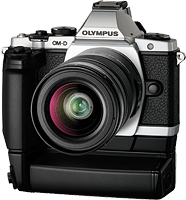Olympus CEO identifies sensor supplier for flagship mirrorless camera
posted Friday, July 6, 2012 at 10:16 PM EDT
 When Olympus announced the flagship OM-D E-M5 compact system camera last February, rumors immediately began swirling. With an effective resolution of 16.1 megapixels, the Olympus E-M5's imager sets a new high tide mark for the company, offering the greatest resolution of any Olympus mirrorless model to date. Which sensor supplier, though, was the source of its image sensor?
When Olympus announced the flagship OM-D E-M5 compact system camera last February, rumors immediately began swirling. With an effective resolution of 16.1 megapixels, the Olympus E-M5's imager sets a new high tide mark for the company, offering the greatest resolution of any Olympus mirrorless model to date. Which sensor supplier, though, was the source of its image sensor?
Perhaps understandably, some identified the sensor used in Micro Four Thirds partner Panasonic's Lumix GH2 as a likely candidate, its output resolution being identical. Others suggested that the more recent sensor used in the DMC-G3 and DMC-GX1 might be a closer relative. The rumor mill also tapped Sony as a potential supplier. For its part, Olympus merely stated that the E-M5 was based around an entirely new sensor design bearing its Live MOS trademark, but declined to identify a source for the chip.
At a press conference in Japan earlier this week, Olympus CEO Hiroyuki Sasa finally put the arguments to rest, identifying the E-M5's sensor supplier in a Japanese-language article uncovered by the 4/3 Rumors website. We've had a native Japanese-speaker translate the article ourselves, and concur with 4/3 Rumors' assessment: the sensor supplier for the Olympus E-M5 is identified by Mr. Sasa as none other than mirrorless rival Sony Corp., whose NEX-series cameras directly compete with Micro Four Thirds models.
It's not terribly surprising to see Sony supplying sensors to Olympus; one has to bear in mind that the company dominates the market for the larger image sensors used in interchangeable-lens cameras. As cited recently by Image Sensors World, Japanese market research company Techno Systems Research believes Sony to hold more than a third of the market for CMOS image sensors, based on dollar value (and excluding certain segments such as unbranded Chinese camera phones.) While it does compete with Olympus in the mirrorless space, it has long treated its sensor and camera divisions as separate entities, and has for years supplied sensors to some of its main rivals in the DSLR market.
What is surprising is that--for whatever reason--Olympus has felt the need to stray beyond its Micro Four Thirds partners. It's been quite a few years since the company last used a non-Panasonic sensor for an interchangeable-lens camera, and even then it was dealing with a partner in the form of Eastman Kodak Co. Sony isn't part of the Micro Four Thirds standard, and given its competing system, that's not likely to change any time soon. It's also interesting in that this is presumably not an off-the-shelf chip; Micro Four Thirds cameras use a sensor size unique to the format, rather smaller than the APS-C sensors in most DSLRs and many of its mirrorless rivals.
We're sure the rumor mill will have fun speculating as to the reasons for this departure...